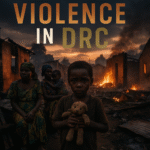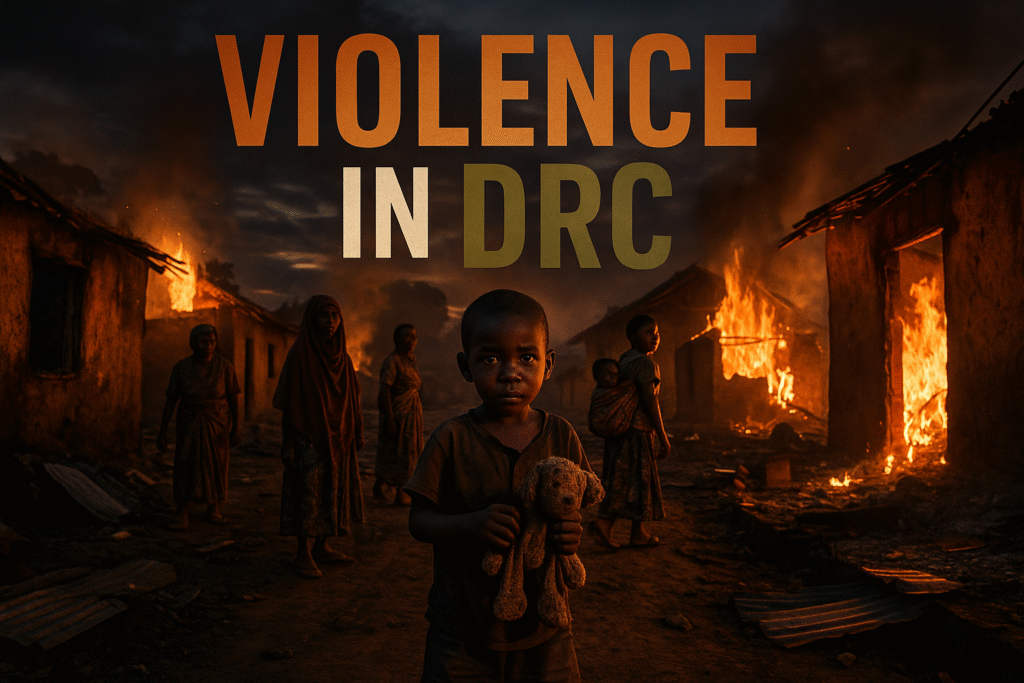

DRC Violence: A Deep Dive
By Darius Spearman (africanelements)
Support African Elements at patreon.com/africanelements and hear recent news in a single playlist. Additionally, you can gain early access to ad-free video content.
ADF Attacks in Ituri Province
The Democratic Republic of Congo (DRC) continues to grapple with severe violence, particularly in its eastern regions. The United Nations Organization Stabilization Mission in the Democratic Republic of the Congo (MONUSCO) recently condemned a brutal attack by the Allied Democratic Forces (ADF) armed group. This horrific incident claimed the lives of 43 civilians in Komanda, Ituri province, between the night of July 26 and July 27, 2025 (monusco.unmissions.org).
Komanda, located approximately 60 kilometers southwest of Bunia in Irumu territory, Ituri, was the scene of this latest atrocity (monusco.unmissions.org). The ADF, an Islamic State-backed rebel group, carried out the attack (upi.com). In addition to the killings, the terrorists set fire to numerous homes and shops in Komanda before retreating into the bush (acninternational.org). This incident follows a previous attack in February 2025, where the ADF murdered around 70 people in a Protestant church in Lubero (churchinneed.org).
MONUSCO's Role in DRC
ADF Origins and Evolution
The Allied Democratic Forces (ADF) has a complex history rooted in regional grievances. The group was formed in the 1990s by former Ugandan rebels who were discontent with Ugandan President Yoweri Museveni (aljazeera.com). Following military assaults by Ugandan forces in 2002, the ADF relocated its activities to the neighboring Democratic Republic of Congo (aljazeera.com).
A significant shift occurred in 2019 when the ADF pledged allegiance to ISIL (aljazeera.com). This affiliation has had profound implications for the group’s operations and the broader regional security landscape. Since this pledge, the ADF has been responsible for the killings of thousands of civilians (aljazeera.com). The allegiance to ISIL has seemingly emboldened the group, leading to an increase in the scale and brutality of their attacks, moving beyond traditional rebel activities to more widespread terror tactics.
Beyond ISIL: ADF Motivations
The motivations driving the ADF’s attacks extend beyond their allegiance to ISIL, encompassing economic opportunism and strategic maneuvering within the chaotic environment of eastern DRC. The group has historically engaged in local revenue generation (reliefweb.int). However, recent trends show a shift towards plunder rather than long-term civilian relations (reliefweb.int).
The instability created by other conflicts, such as the M23 rebellion, allows the ADF to entrench its presence and exploit the resulting power vacuums (reliefweb.int). This situation has led to the displacement of thousands and over 1,600 reported fatalities in North Kivu province in the first three months of 2025 (reliefweb.int). The conflict with the M23 has required the FARDC (Congolese armed forces) to pivot attention away from the ADF, which may permit the ADF to increase deadly civilian attacks in the second half of 2025 (reliefweb.int). Despite a relative lull in the M23 rebellion, the ensuing collapse of authority has provided ample opportunities for the ADF to entrench its presence in the eastern DRC, exposing the local civilian population to the effects of mass violence (reliefweb.int).
Complex Conflicts and Peace Efforts
A complex web of conflicts exacerbates the ongoing violence in the DRC. The DRC army has long struggled against the ADF and is now also grappling with renewed hostilities with the Rwanda-backed M23 rebels (aljazeera.com). This dual challenge strains the military’s resources and capacity to protect civilians.
Despite these challenges, there have been efforts towards peace. On July 19, 2025, the DRC and M23 rebels, reportedly backed by Rwanda, signed a declaration of peace after nearly four years of fighting (upi.com). This declaration is intended to follow the Washington Accord, brokered by the United States (upi.com). However, the persistence of violence, even after such agreements, highlights the deep-seated issues that remain unresolved in the region.
Understanding the ADF
The Allied Democratic Forces (ADF) originated as Ugandan rebels in the 1990s. They moved to the DRC in 2002 and pledged allegiance to ISIL in 2019, significantly escalating their attacks on civilians. Their motivations include economic opportunism and exploiting regional instability.
Obstacles to Lasting Peace
Despite peace declarations, violence persists due to the continued activities of various armed groups, including the ADF and M23. The inability of Congolese forces to simultaneously confront all threats also plays a role (acleddata.com). The ceasefire agreements between Rwanda and the DRC are unlikely to reduce overall violence in the eastern DRC. Instead, they will probably shift violence to other armed groups who will continue taking advantage of the instability to strengthen their own position in the region (reliefweb.int).
This suggests that in months where the M23 captured additional territory, the Congolese forces and allies had limited capacity to also confront the ADF (acleddata.com). This trend suggests the FARDC has limited capacity to confront both the ADF and M23 at the same time (acleddata.com). The recurring outbreaks of violence show that “the underlying issues remain unresolved” (press.un.org). Addressing the conflict’s root causes—including the illicit exploitation of natural resources, historical grievances, and ethnic tensions—must be at the heart of all peace initiatives (press.un.org).
Humanitarian Impact and Aid Challenges
Local populations in the DRC are facing severe challenges due to violence and displacement. This includes mass casualties and widespread sexual and gender-based violence (reliefweb.int). The instability generated by the M23 rebellion and concurrent ADF operations in North Kivu has displaced thousands and already led to over 1,600 reported fatalities in the province in the first three months of 2025 (reliefweb.int).
Aid delivery and access are hampered by ongoing hostilities and restrictions imposed by armed groups. Panama’s delegate pointed to reports of M23’s indiscriminate attacks against hospitals, abductions of civilians, and gang rapes (press.un.org). The United Kingdom’s delegate, expressing support for regional leadership’s ability to deliver a durable resolution of the conflict, called on all parties to respect international humanitarian and human rights laws and allow safe and unimpeded passage of humanitarian assistance by lake, road, and through the reopening of key airports including Goma and Kavumu (press.un.org).
Humanitarian Crisis in DRC
Regional Dynamics and Uganda's Role
Neighboring countries, particularly Uganda, play a significant role in the conflict dynamics. Uganda has deployed troops to eastern DRC to counter the ADF, which has historical ties to Uganda (acleddata.com). This intervention, while aimed at security, adds another layer to the complex regional dynamics.
In response to the rising instability at its borders, Uganda deployed an additional 1,000 troops in February to Ituri and North Kivu, elevating the total number of Ugandan troops to around 5,000 (acleddata.com). Despite a lull in ADF violence since December 2024, the UPDF (Uganda People's Defence Force) claimed that the ADF had moved westward into the densely forested areas of Ituri and North Kivu to avoid confrontation (acleddata.com). In addition to the UPDF, Congolese authorities increasingly recruited and encouraged allied armed groups to support security efforts against the ADF (acleddata.com).
Resource Exploitation and Conflict
The illicit exploitation of natural resources is a significant underlying cause of the conflict in the DRC. This exploitation fuels violence by providing funding for armed groups and exacerbating existing tensions. The recurring outbreaks of violence show that “the underlying issues remain unresolved” (press.un.org).
Addressing the conflict’s root causes—including the illicit exploitation of natural resources, historical grievances, and ethnic tensions—must be at the heart of all peace initiatives (press.un.org). The vast mineral wealth of the DRC, while a potential source of prosperity, has instead become a curse, attracting various armed groups and external actors who profit from the chaos. This economic dimension is crucial for understanding the persistence of violence and the challenges to achieving lasting peace.
ABOUT THE AUTHOR
Darius Spearman has been a professor of Black Studies at San Diego City College since 2007. He is the author of several books, including Between The Color Lines: A History of African Americans on the California Frontier Through 1890. You can visit Darius online at africanelements.org.
